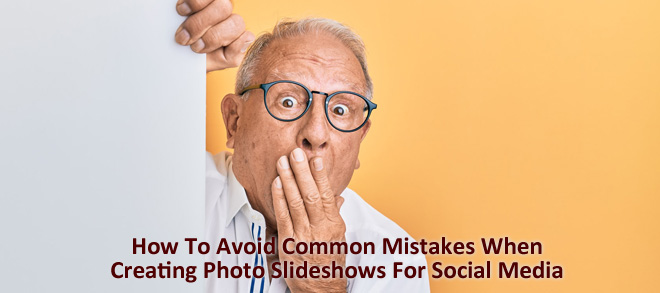Photo slideshows can be created quickly and easily, then saved as video content for social media. With the right approach they can even be very effective, and engage significant numbers of viewers.
Unfortunately there are lots of common mistakes that are made when creating photo slideshows that get in the way of that. Knowing what these mistakes are and how to avoid them is crucial if you want your slideshows to do well on social media:
Too Many Photos and A Slideshow That Is Too Long
The audience that you want to reach on social media is known for having a short attention span. If you start publishing photo slideshows that have over a hundred photos and are 5 or even 10 minutes long – few of them will sit through it.
Instead of that you should try to keep your photo slideshows short. It is good to shoot for slideshows that are about a minute long, and contain 12 to 15 photos.
Photos That Have the Wrong Resolution
If the resolution of your slideshow is 1080p (i.e. 1920 x 1080), your photos should be the same resolution – or close to it. Photos that have a significantly lower resolution will look pixelated when enlarged, and if their aspect ratio is different they will look distorted when made to fit.
Unfortunately there is no easy way to ‘fix’ photos in the wrong resolution. If necessary you can try using a photo editor to upscale and resample photos, and then tidy them up a little. In a photo editor you can crop photos with the wrong aspect ratio to correct them as well.
Text That Is Hard To Make Out
Photo slideshows often have captions and other text added to them – which is great. However if that text is hard to make and seems to disappear into the background it will defeat the purpose.
The color of the text (or at very least – its outline) is important to help avoid this mistake. It is important that the text color contrasts with the part of the photo it is going to be placed on.
Adding In Too Many Animated Transitions Or Effects
Using transitions effectively isn’t easy, and if your slideshow has too many animated transitions and effects it will end up distracting viewers and look tacky. As a rule it is best to just stay away from animated transitions entirely – unless there is a very specific reason why you feel they should be added.
If you do use animated transitions or effects, make sure they are inserted sparingly – and spaced out so that they don’t appear too regularly.
Background Music That Overpowers the Voiceover
If your photo slideshow has both background music and a voiceover, it is important that the former doesn’t overpower the latter. That can be done by adjusting the volume levels of one or the other, or by placing the background music at specific parts of the slideshow – rather than having it play throughout.
Keep in mind that many social media viewers will watch slideshow videos on mute – so you shouldn’t rely too much on the voiceover anyway.
Avoiding the mistakes listed above should be easy enough, and will let you create a more compelling slideshow for social media. Nowadays there are lots of software you can choose from to create the slideshow itself, and for example you could try Animoto, Smilebox, Movavi Slideshow Maker, or even the Windows Movie Maker.
All in all you should be able to quickly and easily create video content for social media in the form of compelling slideshows. More importantly if you successfully avoid the mistakes outlined above, you should be able to engage significant numbers of viewers when you publish them.
[Main Photo by krakenimages on Unsplash]

